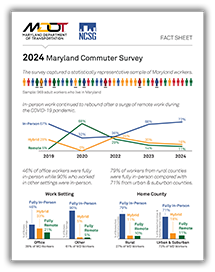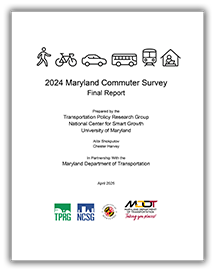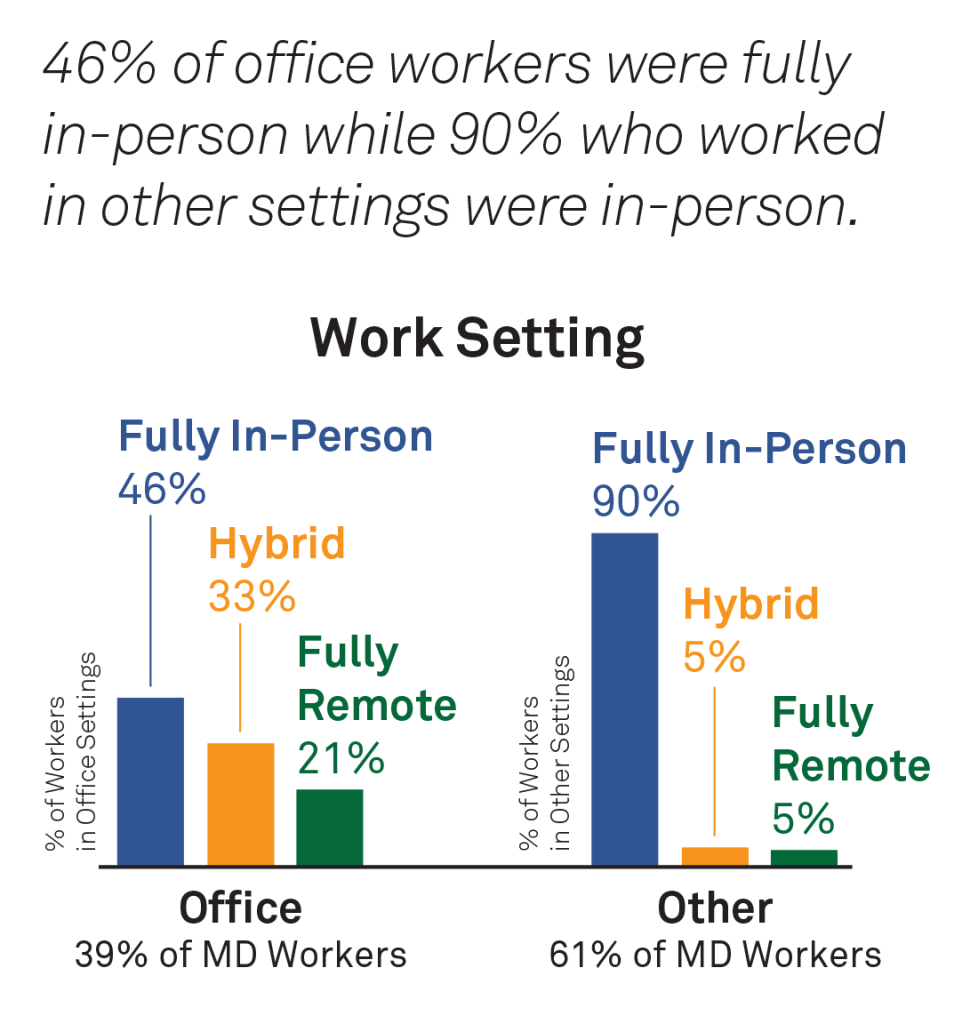2024 Maryland Commuter Survey
The Maryland Commuter Survey (MCS) is an ongoing project conducted by the Transportation Policy Research Group at the University of Maryland in partnership with the Maryland Department of Transportation (MDOT). It provides an annual snapshot of commuting patterns, as well as longitudinal trends as the survey is conducted year-over-year. The 2024 MCS, the survey’s third iteration in its current form, shows how workers across the state have adjusted their work and commuting patterns as the state continues to emerge from the pandemic. This and future versions of the survey will track how workers commute amidst developing economic opportunities and challenges, and preferences about where they live and work. While the MCS focuses on commuting, it also captures other aspects of how workers live, work, and travel, shedding light on how commuting patterns relate to Marylanders’ broader lives.
Key Findings from 2024
Hybrid and Remote Work Stabilizing Near Pre-Pandemic Levels
- The portion of Maryland workers with hybrid and remote schedules dropped marginally from 34% in 2023 to 27% in 2024, but substantially lower than the 64% measured in 2022. This indicates that hybrid and remote work are stabilizing at a general magnitude similar to the pre-pandemic level (33%) measured by a similar survey of Maryland workers.
- Seventy-two percent (72%) of Maryland workers were fully in-person, similar in magnitude to levels from 2023 (66%) and in 2019 (67%), prior to the COVID-19 pandemic.
- Hybrid work declined in 2024 to 20% of workers, below the pre-pandemic level of 24%.
- Fully remote work remained more than twice as prevalent in 2024 (11%) as in 2019 (5%).
- The majority of in-person workers—51% of those working at single worksites (SW) and 61% of those working at multiple or mobile worksites (MMW)—would like to work remotely at least some of the time. Many—44% of SW and 66% of MMW—believed their jobs could be done remotely at least some of the time.
In-Person Work Took Diverse Forms
- Seventeen percent (17%) of workers reported being fully in-person but with multiple or mobile worksites (MMW) rather than the traditional expectation of a single worksite (SW).
- Growth of in-person work between 2023 and 2024 (66–72%) was driven by MMW workers. The portion of SW workers remained consistent at 56%.
- MMW workers included those who commuted from home to a job site that changed regularly (41% of MMW workers), commuted to a central location before additionally traveling to a job site or working a mobile job (29%), and those who worked a mobile job directly from home, without a traditional commute (27%).
- MMW workers had diverse self-reported job titles, including substitute teacher, caterer, dog sitter, Uber driver, doctor, UPS driver, landscaper, traffic flagger, journalist, Doordash driver, mailman, electrician, and translator.
Office Workers Were Disproportionately Hybrid and Remote
- Hybrid and remote work remained disproportionately prevalent among office workers, who made up 39% of the workforce. Thirty-two percent (32%) of office workers were hybrid and 22% were remote, compared with 5% hybrid and 5% remote among all other workers.
- Because hybrid and remote workers were concentrated in office jobs, areas with high numbers of office workers, such as urban centers, have been disproportionately impacted by telecommuting, even as rates of in-person work have rebounded statewide.
Auto Mode Share Increased as the Share of Displaced by Telework Decreased
- Auto mode share for commute trips increased from 69% in 2023 to 74% in 2024 as a decreasing share of trips were displaced by telecommuting: 17% in 2023 to 14% in 2024.
- The portion of commute trips made by transit decreased, despite overall increases in transit volume reported by regional operators. This indicates that new commuters, including those transitioning from telecommuting, adopted transit at a lower rate than auto modes.
- Among transit modes, the share of commutes by bus experienced the sharpest decline, from 8% in 2023 to 5% in 2024.
- Out-of-state and office workers used rail transit, including commuter rail, subway, and light rail, at disproportionately high rates. Forty-two percent (42%) of those who commuted to employers outside of Maryland; 48% of hybrid workers, and 50% of office workers reported commuting by rail at least once during the survey week. For each of these groups, rail transit was the most commonly-used commute mode.
- Active commute mode share increased from 3% in 2023 to 4% in 2024, indicating that new commuters and those transitioning from telecommuting adopted active modes at disproportionately high rates.
Commutes were Increasingly Middle-Distance and Longer in Duration
- Commutes in 2024 were more concentrated at middle distances than in preceding years. The proportion of commutes less than 5 miles one-way dropped from 28% in 2022 to 18% in 2024; commutes greater than 50 miles one-way dropped from 7% to 5% between 2022 and 2024. The share of middle-distance commutes between 10 and 25 miles, meanwhile, increased from 28% in 2022 to 38% in 2024.
- Hybrid workers commuted 41 minutes on average between home and work in 2024, significantly longer than in 2022 (33 minutes). Commutes of hybrid workers in 2024 also averaged significantly longer than their SW in-person counterparts (29 minutes), but were similar to those of MMW workers (37 minutes).
- In 2024, commutes between suburban and urban areas averaged 41 minutes in both directions, indicating comparable inbound and outbound travel times.
- Average commute durations were highest for workers living in northern counties (Frederick: 34 minutes, Carroll: 34 minutes, Hartford: 32 minutes) and southern counties (Calvert: 43 minutes, Charles: 35 minutes, St. Mary’s: 35 minutes). They were lowest for workers from far western (Allegany: 18 minutes) and eastern (Worcester: 22 minutes) counties.
- Counties closer to the metropolitan cores of Baltimore and Washington—Baltimore, Baltimore City, Howard, Anne Arundel, Montgomery, and Prince George’s—had lower average commute durations and distances than more outlying metropolitan counties such as Frederick, Carroll, Hartford, and Charles.
- Average commute durations increased from 2022 to 2024 for workers from most counties, including most counties in metropolitan Baltimore and Washington. Notable exceptions were Howard County, where the average commute decreased by more than four minutes, and more outlying Allegany and St. Mary’s Counties, where average commute durations decreased by approximately 5 minutes.
Limited Transit Feasibility for Most Auto Commuters
- Only 27% of auto commuters had the option to take transit while maintaining a commute that would take no more than twice as long as driving.
- Those who currently commuted by ride-hail or carpool were more likely to have a transit option taking less than twice as long as driving than those who currently drove alone.
- The feasibility of commuting by transit was highest for workers living in Baltimore City—58% of current auto commuters could have commuted by transit in less than twice the time—and lowest in Charles County, where only 14% of current auto commuters had a transit option less than twice their current commute duration.
Documents
| Publication | Date |
| 2024 Maryland Commuter Survey Fact Sheet | April 2025 |
| 2024 Maryland Commuter Survey Final Report | April 2025 |
| 2023 Maryland Commuter Survey Fact Sheet | April 2024 |
| 2023 Maryland Commuter Survey Final Report | April 2024 |
| 2022 Maryland Commuter Survey Fact Sheet | March 2023 |
| 2022 Maryland Commuter Survey Final Report | March 2023 |



